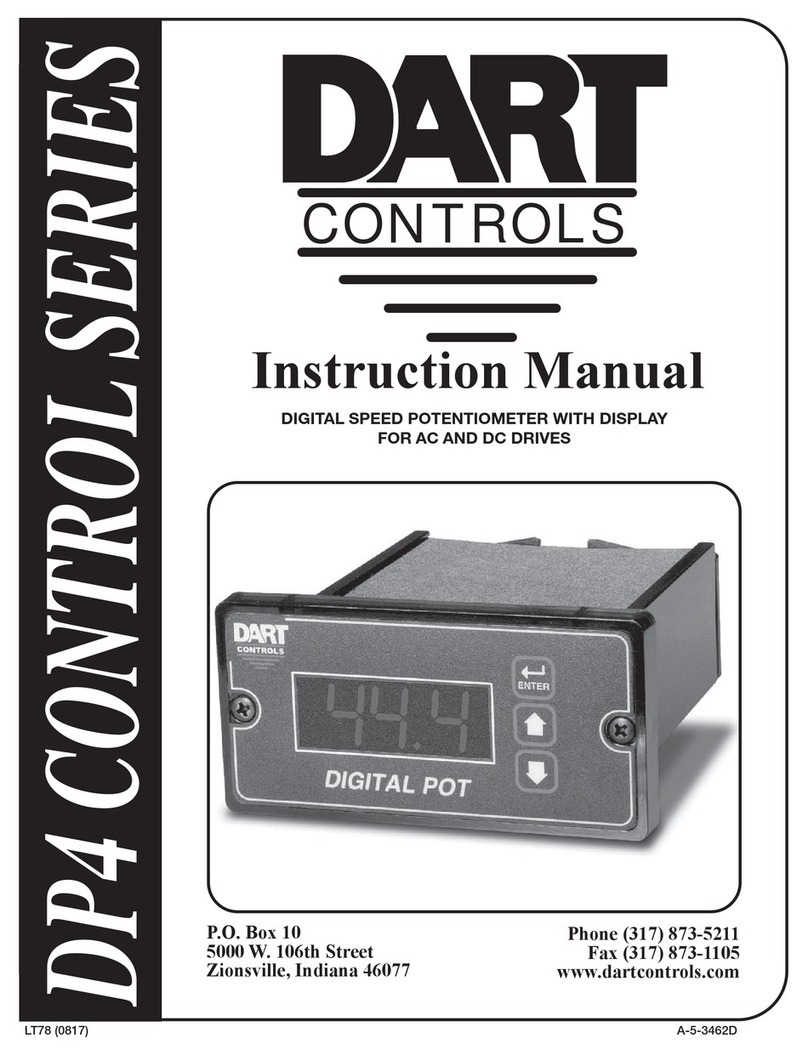
2
Introduction
The DM8000 Series Digital Meter is a powerful, microprocessor-based unit capable of being either field or factory
configured for a number of today’s demanding measurement needs. It can be quickly configured to operate
as a digital rate meter, time in process meter, totalizer, zero-speed switch or feature-filled process counter. It
also offers up to two alarm outputs which can be adjusted for a number of trigger conditions. Utilizing Dart's
modular bus design techniques, the DM8000 is ideal for volume OEM applications requiring specialized inputs
and outputs. Contact Dart Controls' Sales Department for details. This flexibility makes the DM8000 ideal for
applications such as:
Pay-out and Take-up Limit Monitors
Conveyor Oven “Tunnel-Time” Monitors
Rotating Machinery Tachometers
Material Measurement Meters
Its durable 1/8DIN aluminum housing can be easily mounted in a panel or control cabinet. New optional pluggable
terminal block allows the installer to quickly install or replace units without the hassle of physically removing
and reattaching wires. The unit can be ordered with either standard European-style terminal block or optional
“pluggable” connector.
General Features
-Microprocessor-based design combines the ultimate in responsiveness and accuracy in one package
- Selectable display update rate
- Capable of measuring shaft speeds lower than 1 RPM @ 1 pulse per revolution
- Large 4 digit, ½” LED display
- Factory or field programmable via front-panel keypad
- Lexan membrane and gasket (which are included) meet NEMA 4X standards when used with NEMA 4X enclosures
- Internal program-enable jumper selectively prevents tampering with unit’s configuration
- European terminal block or pluggable terminal block available
- Universal power supply accepts line voltages inputs from 85-250VAC @ 50-60Hz without switches or jumpers.
The unit automatically adjusts as needed.
- Non-volatile memory stores adjustable parameters even when power has been removed
- Compatible with a variety of signal input types including: Hall-Effect Pickups, Photoelectric, TTL, etc.
Note: Open collector devices must be capable of sinking 3mA.
- Wide operating ambient temperature range of -10C to 45C (14F to 113F)
- Self-contained power supply for external sensor, limited to 5V @ 50mA
- Up to 2 programmable alarm outputs with Form C contacts rated to 250VAC @ 5A
- Multiple auto-ranging features allow the user to view display values from 0.001 to 99,990 in any user-defined
unit. (GPH, MPH, RPM, etc.)
- Multiple operating modes including:
• Rate Mode – Displays in rate unit such as RPM, Gallons per Second, etc.
• Time Mode – Displays in time unit such as HH:MM, MM:SS, SS:TT, or other unit
• Counter Modes – Displays resettable and reloadable counter value which can optionally
increment or decrement for each input pulse. Quadrature inputs can automatically
be translated to up/down counts for bidirectional applications.
• Rate Mode with Direction indicator – Displays in rate unit such as RPM, Gallons per Second, etc, also
indicates which direction the pick-up is truing.
• Time Mode with Direction indicator – Displays in time unit such as HH:MM, MM:SS, SS:TT, or other unit
also indicates which direction the pick-up is truing.
• Dual Rate Mode – Displays in rate unit such as RPM, Gallons per Second, etc, of two inputs.
• Dual Time – Displays in time unit such as HH:MM, MM:SS, SS:TT, or other unit of two inputs.




























